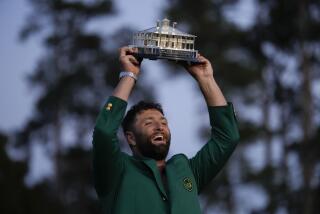Nine books that can turn the page on your golf game
OF THE roughly 16,000 books that have been published on the game of golf, a disproportionate number -- perhaps as high as one-third -- lie in the area of instruction. The reason for this is simple: They sell. A lot. But how does the average golfer sift through this maze of promises (and, frequently, quackery) to determine which titles might be worth acquiring?
Here are nine essential titles, selected for their excellence in clearly and effectively illustrating various aspects of the game. Each is either widely available in stores or easily found on the Internet.
THE CLASSIC
We begin with the full swing, a sub-genre packed with big-name titles, few of which are more essential than “ Ben Hogan’s Five Lessons: The Modern Fundamentals of Golf,” a 1957 classic penned with the great Herbert Warren Wind. Arguably the landmark instruction book of all time, “Five Lessons” began as a series of articles in Sports Illustrated but grew into a full volume containing nearly all of the Hogan theory popularized over the last half-century. Though occasionally a bit confusing for the less knowledgeable, this is surely the most studied golf instructional book of all time.
THE SWING SHOWCASE
Of considerably newer vintage is Ernie Els’ ”How to Build a Classic Golf Swing,” a 1996 volume showcasing the then-26-year-old South African’s legendarily attractive swing. Though chapters on developing rhythm, increasing distance and shaping the ball are especially interesting, the real draw here is an initial 20-page swing sequence that spells out, in easy-to-understand words and pictures, perhaps the most reliably simple method the average player can find to build a fundamentally sound swing.
THE ALL-AROUND GAME
Also worthwhile is “Faldo: A Swing for Life,” a comprehensive title published in 1995. True, skeptics may suggest that Nick Faldo’s success owes mostly to the teachings of David Leadbetter, but as one of the game’s great modern ball-strikers, his thoughts on all aspects of the swing (including the short game and putting) are of paramount interest -- and, in this case, quite coherently laid out.
THE SHORT GAME
Nothing is more important to the average golfer than the short game, where perhaps the definitive title remains Dave Pelz’s “Short Game Bible.” Written by the well-known former NASA physicist, this 1999 tome lives up to its grandiose title, featuring 429 pages covering every aspect of pitching, chipping and sand play, plus a number of angles that even skilled players probably haven’t considered. A bit dry and technical perhaps, but like its sister volume on putting, an essential entry for any book-collecting golfer.
THE PRIMER
Less-trumpeted but similarly valuable is Raymond Floyd’s “The Elements of Scoring,” in which Floyd initially writes: “If somehow I was given your physical game, and we had a match, I would beat you 99 times out of 100. Because I know how to play the game better than you do.” Not much method or style here, just a unique and valuable primer on getting the ball in the hole in the fewest number of strokes.
THE PUTTING GAME
Perhaps because there generally isn’t enough material for a full volume, books dedicated exclusively to putting are comparatively few, but one wonderful title is “The Master of Putting,” an 84-page guide penned in 1983 by that cultish genius of the greens, George Low. Low covers all of the essentials here -- grip, stance, reading greens, the stroke, etc. -- but also has an illuminating chapter analyzing the techniques of 10 of the all-time great putters, from Walter Hagen and Bobby Locke through Jack Nicklaus, Tom Watson and Ben Crenshaw.
THE GREAT ONES
Another popular category includes books dedicated to dissecting the swings of the all-time greats, a concept that surely appeared only moments after some late-19th-century photographer first wandered past the practice range. Many such titles have proved themselves worthwhile (particularly for more advanced readers who know what to look for) but none more so than David Leadbetter’s 1995 work, “Lessons From the Golf Greats,” which uses high-quality color swing sequences (both side and rear) to break down the swings of 25 modern stars in considerable detail.
THE LOOK BEYOND
Finally we find a pair of somewhat novel titles, led by “It’s Only a Game,” Hall of Famer Jackie Burke Jr.’s engaging 2006 volume which offers, in a pleasing style, 185 pages of wisdom drawn from a lifetime in and around golf. And then there is Homer Kelley’s legendary “The Golfing Machine,” a frequently reprinted cult favorite which is, quite simply, the most complicated golf instructional book written. Of course, being based 100% on the laws of physics, it is also very likely the most accurate, but the reader must be ready for a steady diet of “dual vertical hinge action” and the “Catalogue of Basic Component Variations” to stand even the faintest chance of making it beyond Page 18.
But, like all of these titles, it certainly makes for an illuminating read.
More to Read
Get our high school sports newsletter
Prep Rally is devoted to the SoCal high school sports experience, bringing you scores, stories and a behind-the-scenes look at what makes prep sports so popular.
You may occasionally receive promotional content from the Los Angeles Times.






